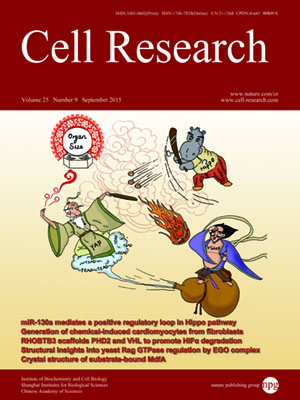
Volume 25, No 9, Sep 2015
ISSN: 1001-0602
EISSN: 1748-7838 2018
impact factor 17.848*
(Clarivate Analytics, 2019)
Volume 25 Issue 9, September 2015: 1013-1024 | Open Access
ORIGINAL ARTICLES
Direct reprogramming of mouse fibroblasts into cardiomyocytes with chemical cocktails
Yanbin Fu1,*, Chenwen Huang1,*, Xinxiu Xu2,*, Haifeng Gu2, Youqiong Ye1, Cizhong Jiang1, Zilong Qiu3 and Xin Xie1,2
1Shanghai Key Laboratory of Signaling and Disease Research, Laboratory of Receptor-based Bio-medicine, School of Life Sciences and Technology, Tongji University, Shanghai 200092, China
2CAS Key Laboratory of Receptor Research, the National Center for Drug Screening, Shanghai Institute of Materia Medica, Chinese Academy of Sciences, Shanghai 201203, China
3Institute of Neuroscience, Key Laboratory of Primate Neurobiology, CAS Center for Excellence in Brain Science, Shanghai Institutes for Biological Sciences, Chinese Academy of Sciences, Shanghai 200031, China
Correspondence: Xin Xie, Tel: +86-21-50801313/156(xxie@simm.ac.cn)
The direct conversion, or transdifferentiation, of non-cardiac cells into cardiomyocytes by forced expression of transcription factors and microRNAs provides promising approaches for cardiac regeneration. However, genetic manipulations raise safety concerns and are thus not desirable in most clinical applications. The discovery of full chemically induced pluripotent stem cells suggest the possibility of replacing transcription factors with chemical cocktails. Here, we report the generation of automatically beating cardiomyocyte-like cells from mouse fibroblasts using only chemical cocktails. These chemical-induced cardiomyocyte-like cells (CiCMs) express cardiomyocyte-specific markers, exhibit sarcomeric organization, and possess typical cardiac calcium flux and electrophysiological features. Genetic lineage tracing confirms the fibroblast origin of these CiCMs. Further studies show the generation of CiCMs passes through a cardiac progenitor stage instead of a pluripotent stage. Bypassing the use of viral-derived factors, this proof of concept study lays a foundation for in vivo cardiac transdifferentiation with pharmacological agents and possibly safer treatment of heart failure.
10.1038/cr.2015.99
FULL TEXT | PDF
Browse 2900


